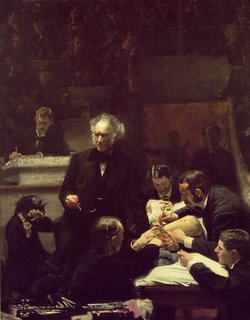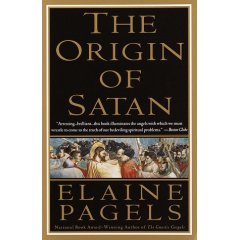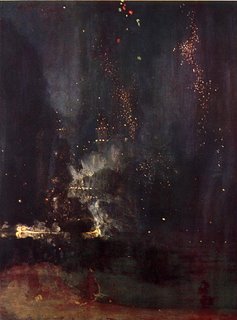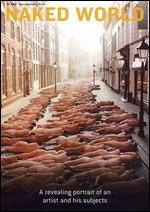Last Thursday, I attended the
Iraq for Sale showing on campus. Aside from being a very well made film about the non-partisan topic of war profiteering and its effects, it was introduced by a wonderful speech by student Tate Marble. He has given me permission to distribute it as I see fit, so I decided to put it here in my art blog:
"
I would like to welcome all of you here tonight. I would also like to thank the Honors Committee and The Omni Center of Fayetteville for helping us create this forum. Also, before I begin, I need to thank a few individuals who helped make this event happen.
Dr. Vervack was instrumental in seeing that this gathering would create a learning environment that NWACC, the community, and anyone attending would be proud of. His work is tireless, his mind one of the sharpest I have met in all my travels, his character, commitment, kindness, and integrity are a tremendous asset to this school and we, quite frankly, are lucky to have him.
Professor Laughton, one of the better teachers I have ever encountered, never dismissed or endorsed this program but, instead, understood that I was a student who had a need to share a point of view and encouraged this from day one. His quick conversations with me outside the classroom encouraged me not to fold the dream of presenting this film to all of you tonight. His remark was simple but strong when he said,” That I must follow my passion”.
Professor Mckay, is an instrumental part of what we see here tonight. Her desire to see students learn and react to information takes this institution to the next level of learning. Her guidance, encouragement, and desire for our group to realize that “One small act can change the world” has taught me alot about myself and what it takes to really create change. She is the definition of an educator; a definition that anyone entering the profession should try to emulate.
All of these individuals deserve a round of applause for making this event possible.
By being here, amidst long work days, children, and a myriad of other possible scenarios you have shown your willingness to sacrifice for this country and your concern about the direction we are headed.
This concern is what has created this event. In fact, this event began some time ago with a simple telephone call and has grown to what you see here today. I realized this and other revelations for the first time tonight as I made my way through the I-540 traffic. For me, these epiphanies are rare. Rare in that it is so very uncommon to see something so clearly, in it’s purest form, that I usually grab for the nearest pen or pencil, regardless of where I am, to jot it down. In this case, that was while I was crawling along amidst most of the rest of North West Arkansas, and my only source of paper was the extra McDonald’s napkin that, I think for everyone, ends up in the middle console of our vehicles. Mosses had his burning bush, Mohammed had his vision in a cave, and I had my napkin. However, on it I think I captured the essence of why we are all sitting here, why this topic causes so much debate and controversy, and why, myself included, many of us lay our heads at night fearful of what the next day will bring for this great nation.
As mentioned before, we are here because we are seeking answers. Simply, we, as American’s, need all the facts in order to fully understand, contemplate, digest, form a well thought out opinion, and to feel as though we have done our due-diligence and have come to an intelligent decision about whether our country is progressing in a direction we are comfortable with. Simple enough. Scary also, because we only get one shot at this. We can’t simply click the “do-over” button once the game has ended. Within this mindset, we are here because we know, inherently, that this country is changing at a rapid pace and any information that helps us to obtain a clearer picture is worthy of one evening away from home and out of our normal routines.
So, you all are to be applauded for being here and caring as much as you do.
As my napkin got fuller I also realized that the movie you see tonight will shock you. It shouldn’t, but it certainly will. It became clear to me that we, as a people, have become lazy. We want express mail, overnight service, 3 minute McDonald’s lines, and our world news in 30 minutes or less.
We have gotten so entranced in our daily lives; lives that could use more than twenty-four hours to accomplish all we need and want with our children, family, friends, and anything else you can think of that we do nothing to further our understanding of the world, investigate other sources of information, or question or verify what we are told nightly……In essence, we simply don’t do our homework. We are, without question, the least savvy nation in the world when it comes to understanding America’s global identity.
Instead, we grasp tightly to half-truths and the belief that the ken or Barbie doll force feeding us a strict diet of Government censored news would never lie to us. They wouldn’t do that…..we have watched them for years!
The fact is, America will never know because we haven’t made knowledge of world issues a priority in our lives since the 60’s and early 70’s. Look how many people showed up at the opening of the new mall and how many are seated here tonight. I don’t think the numbers are greatly exaggerated because Wayne Newton was there. This is what we have become and I believe that has done more harm to the stability of this country than anything I can think of. The simple truth is: we are lazy and the men and women at the big corporations you are going to learn about understand this fully. Simply, they are getting rich while we are trying desperately to jot down the recipe on Rachel Ray’s thirty minute meals. Some of the CEO’s and Presidents you witness here tonight made more money in a year, which our country will go broke trying to repay, than we will make in our lifetimes. The numbers are staggering.
This is a much longer summation of the short sentence I was able to scribble on my napkin. It read, simply, “We need to make understanding a priority.”
Finally, on the final two inches of space remaining on that old napkin, I simply wrote: That we can parish through patriotism. That is a loaded statement but one that needs to be voiced.
What I, and others are doing here tonight, might be seen as un-patriotic. Many in this country and community, I’m sure, would agree with that. Some, within this school have, and I am paraphrasing, voiced strong opposition. Why? I asked?
Why do I, and many of you, see this picture of our country so vividly while others struggle to see anything remotely similar? How can that be?
While answering this…and writing over the McDonalds logo I think I figured it out. It may be hard to swallow for some but it seems to be the only reason we get such a split in opinion when the public is tallied.
In simple terms: they (many within this society) have been sold. They have bought the speeches hook line and sinker, they have never demanded sufficient evidence to back up any claims they would gladly go to blows over, they believe that every cars bumper is strictly reserved for a yellow ribbon or an American flag and that any deviation of said bumper warrants the customary yell “If you don’t like it then get the @!*** out!”
They have bought the lie and I have no personal animosity towards them. I do, however, feel sad for them.
Sadness because their intentions are good; their opinions are just cultivated from bad information, from a lack of personal motivation to seek the truth, from believing that the good ole boy president would never do anything like that, from believing that those bastards came here and hit us; so we are hitting em’ back, from the criminally censored outlets that serve us our news nightly, from the daily rise and fall of the greatest scare tactic ever invented…..the terror meter, from not understanding that our Imperialistic regime in Washington cares very little about democracy anywhere in the world; instead it foams at the mouth at the thought of helping old fraternity brother, old friends, and old co-workers( running some of the most powerful corporations on the planet) make a killing, from the propaganda we are fed daily, from the committees of hand-picked supposed truth seekers that never find any wrong doing ( that stems from JFK until present day), from pulpits around the country that mistake the notion of “support our troops” ( which we all should do) with “support our President”, from the financers and money-changers who have strapped us so tightly with debt we simply don’t have time to breath, working 10-12 hour days to support our families, from believing that “If your not with us, your with the terrorists” are really the only two options we have, From casting off the unimaginable to protect the little sense of truth we yearn to hold on too, from not allowing ourselves to view death as more than numbers scrolling across the Fox news ticker, From not seeking all possible information and opinions; instead we settle nightly for what allows us to lay our heads on the pillow and feel “just” about the days events, and on and on it goes.
Their canned remarks and rebuttals are easy. They require nothing more than acceptance and very little of the “personal journey” that would allow them to comment based on “hard work” and “time spent”. They are, in my opinion, the transcript of what was aired the night before; yet they can only paraphrase and quote because nothing they say belongs to them…nothing is unique.
Within the aforementioned mindset I see the individuals I fear the most. I see them waving their flags, cooking their apple pie, and hanging their commander-and-chief’s picture above the mantle……at the same time they see not the constitution that has been eroded, the manipulation of the justice system that has occurred, and the permanent changes (to our country) that have altered who we are and how we will be viewed from here on out.
These individuals, who have chugged the proverbial Bush kool-aid need our help. Without the awakening of America from it’s long slumber we may eventually wake to find ourselves, our children, and our loved ones living in a frail shell of what once was a country “For the people, by the people”. Those days, I fear, are growing short.
As I mentioned above….we only get one chance to get this right. This night will mark the a change (for some) and an end of a long journey for others; their last stand to try to right this ship. The wheelhouse will sit empty and our ship will float lifeless and vulnerable unless we all step up and grasp firmly to the wheel, muscle it back against the forces imparting their will upon it, and save it from the deep dark abyss.
We are all captains here tonight. Together we can navigate the roughest of seas, master the winds, and, together, set a steady course.
This is our ship! I stand here tonight to save her. I know she can still sail, still remains the greatest ever built! The name on her stern is colored in the famous red, white, and blue. It is a bold writing, meant to represent the strength of this great nation. Her name simply reads: America!
Grab the wheel tonight and decide, here and now, to never let it be pried from your hands again. This country will continue to prosper if we do so."





 I finally finished this book. It took me so long because it is a lot to chew on, especially when you don't have a lot of time to enjoy a good book. As the title implies, this book gives us the chronicle of the life, history, character, and personality of the being called "Satan." Elaine Pagels does a thorough job as always elucidating complex theology and theological history for the lay person. The entity of Satan has changed numerous times over Judeo-Christian history. This is the history she focuses on and does not address other religions' evil entities.
I finally finished this book. It took me so long because it is a lot to chew on, especially when you don't have a lot of time to enjoy a good book. As the title implies, this book gives us the chronicle of the life, history, character, and personality of the being called "Satan." Elaine Pagels does a thorough job as always elucidating complex theology and theological history for the lay person. The entity of Satan has changed numerous times over Judeo-Christian history. This is the history she focuses on and does not address other religions' evil entities. I've been preparing for my Art History II class, looking particularly at 15th century Florentine early Renaissance art. I decided to check into a historical figure a little more deeply. His name is Girolamo Savonarola. When I was younger, I was taught that he was a great early pre-Luther reformer. Turns out, he was an ignorant dictator.
I've been preparing for my Art History II class, looking particularly at 15th century Florentine early Renaissance art. I decided to check into a historical figure a little more deeply. His name is Girolamo Savonarola. When I was younger, I was taught that he was a great early pre-Luther reformer. Turns out, he was an ignorant dictator. I especially like the warm, orange glow at the bottom and little tracers coming off the spark.
I especially like the warm, orange glow at the bottom and little tracers coming off the spark. The red streamers are nice in this one.
The red streamers are nice in this one. Again, the red streamers are good, but also the strange glow of the cinderblock in the firelight.
Again, the red streamers are good, but also the strange glow of the cinderblock in the firelight. The prickly light at the top of this firework is beautiful.
The prickly light at the top of this firework is beautiful. This one was just blazing!
This one was just blazing! This one went up in the air and I caught the trail in my camera. It's strangly feathery.
This one went up in the air and I caught the trail in my camera. It's strangly feathery. I caught this one during its white-hot phase.
I caught this one during its white-hot phase. I actually got some color in this shot.
I actually got some color in this shot. This one looks like the end of a blowtorch.
This one looks like the end of a blowtorch. Crazy colored hairy spider legs.
Crazy colored hairy spider legs. I think this is my favorite shot, because I caught the fiery launch AND the puffs of smoke.
I think this is my favorite shot, because I caught the fiery launch AND the puffs of smoke.
 I watched this HBO documentary the other night. It was really quite beautiful seeing the artist's process behind the scenes. He took his camera and his crew to seven continents. It was intriguing learning about the different mores regarding nudity in the models as well as the spectators in the various cultures. Some were quite surprising in this regard. Let's just say France's mores aren't what you think and neither are England's when it comes to nudity. Some people, like the Russians, put a political spin on their nudity.
I watched this HBO documentary the other night. It was really quite beautiful seeing the artist's process behind the scenes. He took his camera and his crew to seven continents. It was intriguing learning about the different mores regarding nudity in the models as well as the spectators in the various cultures. Some were quite surprising in this regard. Let's just say France's mores aren't what you think and neither are England's when it comes to nudity. Some people, like the Russians, put a political spin on their nudity. One of my favorite guilty pleasures is watching horror films. I like them for entertainment value, but mainly, I like them as an act of defiance. I DARE them to scare me. I've always believed that real life terror eclipses whatever Hollywood can come up with in terms of fear, and most horror films come off as dark or tragic comedies.
One of my favorite guilty pleasures is watching horror films. I like them for entertainment value, but mainly, I like them as an act of defiance. I DARE them to scare me. I've always believed that real life terror eclipses whatever Hollywood can come up with in terms of fear, and most horror films come off as dark or tragic comedies.



 NOTE: Before you read this KNOW that I love and read comics and am a huge fan of the superhero genre (particularly drawn to the misfit or mutant themes).
NOTE: Before you read this KNOW that I love and read comics and am a huge fan of the superhero genre (particularly drawn to the misfit or mutant themes).







